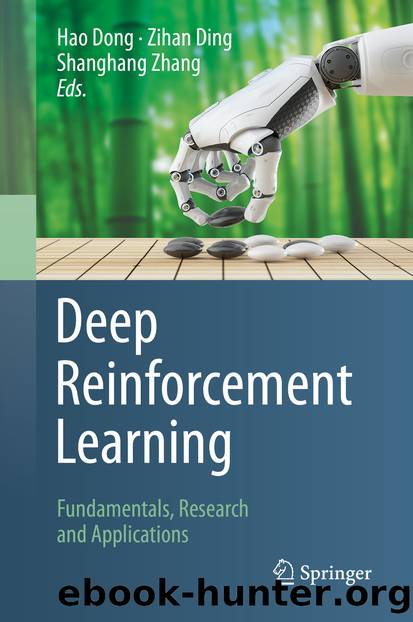Deep Reinforcement Learning by Unknown

Author:Unknown
Language: eng
Format: epub
ISBN: 9789811540950
Publisher: Springer Singapore
7.7 Sim to Real
Reinforcement learning methods can successfully solve a large variety of tasks in simulated environments, and can sometimes even beat the best human performance for specific areas as in the game of Go. However, the challenge of applying reinforcement learning methods for real-world tasks remains unsolved. Apart from playing Atari games, strategy computer games, or board games, potential applications of reinforcement learning in real world include robotics control, autonomous driving vehicles, autonomous drone control, etc. These tasks which involve real-world hardware usually have high requirements for safety and accuracy. For these cases, a single operation by mistake can even lead to disastrous results. This is a more considerable problem when the policy is learned with reinforcement learning methods, of which the exploration process makes great differences for the learning agent without even considering the sample complexity in real world. Modern machine control in industry still depends heavily on traditional control methods, instead of state-of-the-art machine learning or reinforcement learning solutions. However, it is still a wonderful dream of controlling those physical machines with a smart agent that plenty of researchers in corresponding areas are working towards.
Recent years have seen the application of deep reinforcement learning to a growing repertoire of control problems. But due to the high sample complexity of reinforcement learning algorithms and other physical limitations, many of the capabilities demonstrated in simulation have yet to be replicated in the physical world. We will demonstrate the ideas mainly with the robot learning example, which is a more and more active research direction attracting attentions from both the academia and the industry.
Guided policy search (GPS) (Levine and Koltun 2013) represents one of the few algorithms capable of training policies directly on a real robot within limited time. By leveraging trajectory optimization with learned linear dynamics models, the method is able to develop complex manipulation skills with relatively small numbers of interactions with the environment. Researchers have also explored parallelizing training across multiple robots (Levine et al. 2018). Kalashnikov et al. (2018) also propose the QT-Opt algorithm with a distributed training framework on 7 real robots at the same time, but with a cost of 800 robot hours data collection over the course of 4 months. They demonstrate the successful cases of robot learning directly deployed in real world, but the time consumption and requirement of resources are unbearable. Furthermore, successful examples of training policies directly on physical systems have so far been demonstrated only on relatively restrictive domains.
Sim-to-real transfer is an alternative approach for directly training deep reinforcement learning agents in reality, and is attracting more attention than before due to the development of simulation performances and other facts. Instead of directly training in real world, sim-to-real transfer works through a quick learning process in simulation. Recent years have seen great achievements in sim-to-real approaches for successfully deploying reinforcement learning agents in reality (Andrychowicz et al. 2018; Akkaya et al. 2019). However, the approach of sim-to-real has its own drawbacks compared with directly deploy training processes in real
Download
This site does not store any files on its server. We only index and link to content provided by other sites. Please contact the content providers to delete copyright contents if any and email us, we'll remove relevant links or contents immediately.
Algorithms of the Intelligent Web by Haralambos Marmanis;Dmitry Babenko(16233)
Jquery UI in Action : Master the concepts Of Jquery UI: A Step By Step Approach by ANMOL GOYAL(9385)
Test-Driven Development with Java by Alan Mellor(7729)
Data Augmentation with Python by Duc Haba(7606)
Principles of Data Fabric by Sonia Mezzetta(7378)
Learn Blender Simulations the Right Way by Stephen Pearson(7294)
Microservices with Spring Boot 3 and Spring Cloud by Magnus Larsson(7137)
Hadoop in Practice by Alex Holmes(6587)
RPA Solution Architect's Handbook by Sachin Sahgal(6513)
The Infinite Retina by Robert Scoble Irena Cronin(6215)
Big Data Analysis with Python by Ivan Marin(5930)
Life 3.0: Being Human in the Age of Artificial Intelligence by Tegmark Max(5506)
Pretrain Vision and Large Language Models in Python by Emily Webber(4893)
Infrastructure as Code for Beginners by Russ McKendrick(4651)
Functional Programming in JavaScript by Mantyla Dan(4434)
WordPress Plugin Development Cookbook by Yannick Lefebvre(4379)
The Age of Surveillance Capitalism by Shoshana Zuboff(4242)
Embracing Microservices Design by Ovais Mehboob Ahmed Khan Nabil Siddiqui and Timothy Oleson(4146)
Applied Machine Learning for Healthcare and Life Sciences Using AWS by Ujjwal Ratan(4134)
